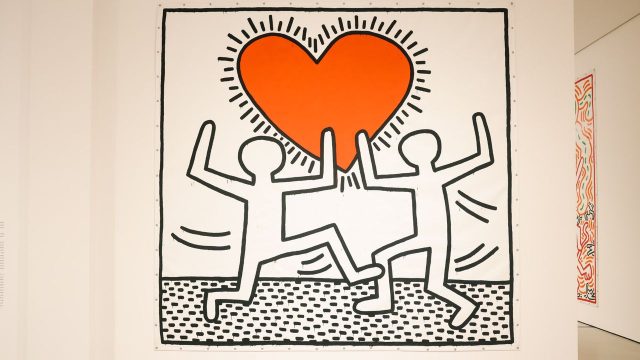
A large Andy Warhol portrait of Jean-Michel Basquiat in a jock strap is the first thing you see at “Downtown/Uptown.” And the choice is fitting, said J. Scott Orr in Whitehot, because the towering electric-red silk-screen image “captures everything about ’80s art: the need to shout above cultural noise, the wholesale packaging of sexuality, and the commodification of, well, everything.” Warhol, then in his 50s, was the new generation’s spirit guide and Basquiat a rising star, about to lead a New York City–based cohort including Julian Schnabel, Keith Haring, David Salle, and Barbara Kruger to a level of pop celebrity that was unknown a decade earlier. Those artists and roughly 20 more are featured in this all-star group gallery exhibition co-curated by 1980s gallerist and impresario Mary Boone, who helped blur the lines between art and commodity, rebel and entrepreneur. The show succeeds “because it refuses to sanitize that legacy.”
Though the show includes 78 works by 26 artists in all, it’s “nowhere near exhaustive,” said Max Lakin in The New York Times. It highlights the return of figurative painting in a style that critics called neo-expressionism, a label that didn’t please most artists. Basquiat, Schnabel, Haring, Francesco Clemente, and Eric Fischl all belonged to this “hot-blooded” group and were shown at Boone’s downtown gallery. Many of the era’s cerebral photographers and appropriation artists instead showed at Metro Pictures, but their kind is represented here by Kruger, Cindy Sherman, and Jeff Koons. Women are underrepresented, said Veronica Esposito in The Guardian, because “the plague of sexism” remained virulent in the ’80s. But the Guerrilla Girls, an anonymous art collective, have some of their wittiest posters displayed, each one challenging men’s domination of the art world.
The vibrant scene captured by “Downtown/Uptown” is “colored a bit by survivorship bias and nostalgia,” said Marion Maneker in Puck. Because co-curator Brett Gorvy was a London teenager when all these artists burst into prominence, “the exhibition is very much the 1980s New York of his imagination.” Several of the era’s most controversial works even share their own room, bringing together two Sally Mann photographs of her nude children, a Richard Prince image featuring a nude 10-year-old Brooke Shields, and Andres Serrano’s photograph of a crucifix immersed in his own urine. But the show as a whole celebrates the explosive creativity of the era, providing a useful lesson for today’s U.S. art scene, currently in a lull nowhere near as deep as that of the ’70s. “Even when the art world is at its bleakest, you never know what’s coming next.”
Lévy Gorvy Dayan, New York City, through Dec. 13




